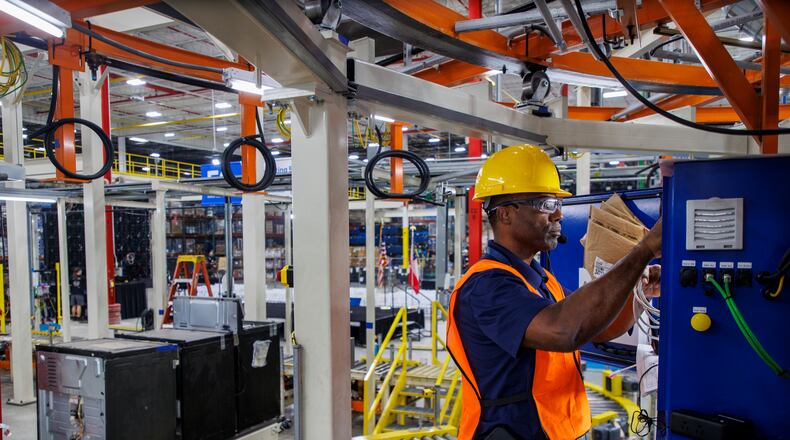The Georgia economy added 4,400 jobs last month, slightly better than an average, pre-pandemic June, although it was the weakest expansion since October, the state Department of Labor said Thursday.
The state’s unemployment rate held steady at 3.2%, right where it was in May, making it the 24th consecutive sub-4% month — the second-longest such streak on record. Georgia’s jobless rate also remained lower than the national number, as it has been since before the COVID-19 pandemic started in 2020.
Georgia has added 109,900 jobs during the past year, with last month’s growth led by hiring in accommodation and food services, health care and manufacturing, said Bruce Thompson, state labor commissioner.
“Georgia continues to become an economic powerhouse,” he said.
Despite massive job losses early in the pandemic, the economy now has 232,100 more jobs than in February 2020 with just a few sectors — including state government — still short of their previous levels.
The pace of hiring has moderated, mostly due to the Federal Reserve’s interest rate hikes, an anti-inflation campaign that has raised the cost of borrowing for businesses and consumers, dampening the enthusiasm for spending.
Yet growth has continued, if more modestly. And the labor market continues to work its way through changes in demographics, employer needs and worker expectations.
A trifecta of unique demographic and social challenges have hit the jobs market at once — spurring some companies to complain of a shortage in skilled labor. Boomers are retiring. Many workers are grappling with the challenges of caring for older relatives and children. The effects of COVID-19 also linger still.
The labor force — everyone either working or actively searching for a job — has grown, but not as fast as demand for workers.
While many of the recent headlines about job growth have been about production facilities for electric vehicles and batteries, some old-school manufacturing is more than holding its own.
In LaFayette, the 1.4 million-square-foot Roper Corp. factory turned 50 years old. It’s also wrapping up a $110 million expansion that’s seen its workforce grow from 1,800 to 2,500 in two years.
Roper, which is owned by GE Appliances, each year churns out millions of ovens, ranges and cooktops, and with new construction of homes picking up and many other homeowners spending money on renovations, demand for its products has been strong, said Luther Ingram, company president.
Boomers, once the dominant share of the labor force, now account for just 10% of Roper’s workers, Ingram said.
LaFayette is only about three times the size of Roper’s workforce. So the plant has adopted strategies aimed at getting the work done, he said. “New generations want more flexibility. We’ve gone to a four-day week. That has been a game-changer for us.”
Moreover, many employees are now drawn from a pool of people who have childcare concerns, classes to attend or just a preference for part-time work. They use an app to schedule their weekly hours, from eight up to 40, Ingram said. “This is a model you’ll start seeing more and more.”
The pandemic sparked an unprecedented churn among workers, with millions of people leaving positions for what they thought was something better — pay, benefits, hours, flexibility or just time away from work. That has stressed some employers who are continually paying to find and train replacements.
In hospitality, which was especially roiled by the pandemic, growth has been robust with about 40,000 jobs added in the past year. Despite the higher interest rates, consumer spending has been healthy, and the sector still has more job openings than any other on the state’s online listings, according to the Department of Labor.
“We’ve had some ups and downs, but we are doing fairly well,” said Joey Ward, chef and co-owner at Southern Belle and Georgia Boy, adjacent eateries in the Poncey-Highland section of Atlanta. “We made it through what was arguably the hardest time in the history of restaurants.”
Flexibility can be crucial in retaining restaurant workers, too, he said.
The twin restaurants are open just three evenings a week, workers get two weeks’ paid vacation and by including tips in the menu price pay is more predictable, Ward said.
“It’s a huge investment to train staff,” he said. “How we take care of our employees has led to less turnover.”
Pay has also been rising, along with more options and flexibility for workers. All that draws more people into the market. In 2019, employed people made up 55.6% of the state’s total working-age population. The Department of Labor said Thursday that the ratio is now up to 59.4%.
Georgia jobs by the numbers
Job growth, June
Recent: 4,400 (June 2023)
Average, pre-pandemic: 4,000
Best, pre-pandemic: 17,400 (2015)
Worst, pre-pandemic: -11,900 (2009)
Unemployment rate, Georgia
Recent: 3.2% (June)
Previous: 3.2% (May)
Lowest on record: 2.9% (April, May 2022)
Highest, pre-pandemic: 10.9% (Nov. 2009)
Recent months, unemployment below 4%: 24
Longest such streak: 27 (1999-2001)
Strongest hiring, June
Accommodation and food services
Health care and social assistance
Durable goods manufacturing
Construction
Top industry job listings
Health Care
Administrative and support services
Retail
Professional, scientific and technical services
Accommodation and food services
Sources: Bureau of Labor Statistics, Georgia Department of Labor
About the Author
Keep Reading
The Latest
Featured


